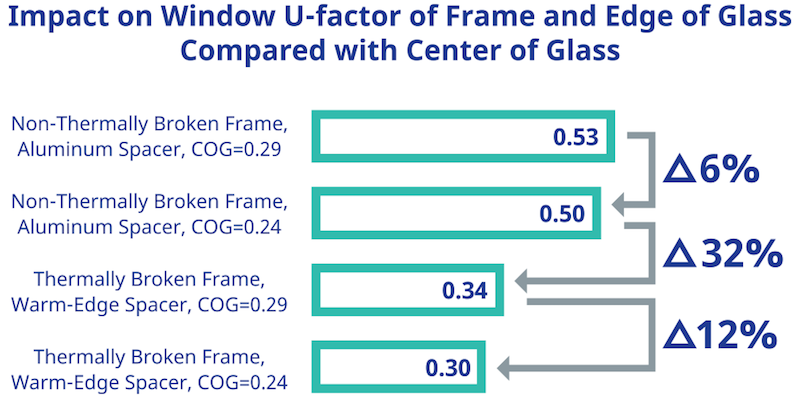Over the years, our industry has relied heavily on reducing the center of glass (COG) U-factor as a way of driving down overall fenestration U-factors (thermal transmittance). Strategies have included increasing the performance of low-emissivity (low-e) coatings, using multiple coatings, addition of inert gases, and more recently, moving to triple-pane units. However, the COG U-factor makes up only part of a window’s performance. To achieve the lowest fenestration thermal transmittance and highest condensation resistance, it is necessary to look more broadly at the window as a system, including the edges: The frame and edge of glass (EOG).

 Think of a window as the thermal equivalent of damming a river at its center, yet forgetting to block water flow all the way to its banks.
Think of a window as the thermal equivalent of damming a river at its center, yet forgetting to block water flow all the way to its banks.
Focusing on preventing heat flow through the COG only is the thermal equivalent of damming a river at its center, but not spanning the entire river. In the case of the river, the water just flows around the edges. Likewise, in the case of the window, the energy still flows through it even if the COG conductance is low. It does so by taking the path of least resistance around the edges of the window – through the frame and EOG.
 Whole fenestration U-factor as a function of center of glass (COG), edge of (EOG) and frame thermal performance.
Whole fenestration U-factor as a function of center of glass (COG), edge of (EOG) and frame thermal performance.
The graph illustrates how the window U-factor varies with the COG, frame and EOG (spacer) performance, and demonstrates how the specifications of the edges of a window control the overall U-factor performance. The data confirms that when specifying a fenestration system, the first focus should be on improving the performance of the frame (biggest influence) and EOG before specifying the COG package. Spec the edge.
Having a high-performance edge is an enabler for achieving a high-performance window system, and it can provide greater flexibility in glass choice because the highest COG U-factor may not be needed. A top-performing frame can achieve the same performance with a dual-pane glazing as a poorer-performing frame with triple-pane glazing.
Because condensation resistance is also driven by thermal bridging (or lack thereof) at the fenestration edge, improving frame and EOG thermal performance first has a dual benefit of increasing performance on this dimension too. For the example above, the condensation resistance of the non-thermally broken window wall is only 40 compared to 53 for the thermally broken system.
The moral of the story is that when designing windows for thermal and condensation-resistance performance, start with the edge first. Doing so delivers higher performance and more flexibility, reduced complexity and potentially reduced cost for the glazing in-fill. In other words, before getting caught up in the middle, spec the edge. To learn more, visit https://spectheedge.com/
Related Stories
Products and Materials | Jan 18, 2023
6 innovative products for multifamily developments
Here are six innovative products for various multifamily developments, including a condominium-wide smart electrical system, heavy-duty aluminum doors, and prefabricated panels.
Sponsored | | Dec 14, 2022
Ballistic Glazing: Windows and Doors Designed for Security and Protection
For building teams choosing and applying bullet-resistant glass systems, understanding test criteria and ballistics attack types is essential
75 Top Building Products | Nov 30, 2022
75 top building products for 2022
Each year, the Building Design+Construction editorial team evaluates the vast universe of new and updated products, materials, and systems for the U.S. building design and construction market. The best-of-the-best products make up our annual 75 Top Products report.
K-12 Schools | Nov 30, 2022
School districts are prioritizing federal funds for air filtration, HVAC upgrades
U.S. school districts are widely planning to use funds from last year’s American Rescue Plan (ARP) to upgrade or improve air filtration and heating/cooling systems, according to a report from the Center for Green Schools at the U.S. Green Building Council. The report, “School Facilities Funding in the Pandemic,” says air filtration and HVAC upgrades are the top facility improvement choice for the 5,004 school districts included in the analysis.
Building Materials | Nov 2, 2022
Design for Freedom: Ending slavery and child labor in the global building materials sector
Sharon Prince, Founder and CEO of Grace Farms and Design for Freedom, discusses DFF's report on slavery and enforced child labor in building products and materials.
Building Materials | Aug 3, 2022
Shawmut CEO Les Hiscoe on coping with a shaky supply chain in construction
BD+C's John Caulfield interviews Les Hiscoe, CEO of Shawmut Design and Construction, about how his firm keeps projects on schedule and budget in the face of shortages, delays, and price volatility.
Sponsored | BD+C University Course | May 3, 2022
For glass openings, how big is too big?
Advances in glazing materials and glass building systems offer a seemingly unlimited horizon for not only glass performance, but also for the size and extent of these light, transparent forms. Both for enclosures and for indoor environments, novel products and assemblies allow for more glass and less opaque structure—often in places that previously limited their use.
Windows and Doors | Jan 19, 2022
Crystal Windows key to Jersey City historic restoration
Landmark repurposed for retail, offices, art studios, and loft apartments.
3D Printing | Jan 12, 2022
Using 3D-printed molds to create unitized window forms
COOKFOX designer Pam Campbell and Gate Precast's Mo Wright discuss the use of 3D-printed molds from Oak Ridge National Lab to create unitized window panels for One South First, a residential-commercial high-rise in Brooklyn, N.Y.
Windows and Doors | Dec 15, 2021
Schweiss Doors bifold door opens to performance center at high-tech Utah student complex
One of the first things you may ask yourself when you hear about the Spy Hop Productions building at Salt Lake City, is “What is Spy Hop?” Sounds like something out of a James Bond 007 movie! Actually, the meaning of Spy Hop is a vertical half-rise out of the water performed by a whale in order to look ahead, tune in or view the surroundings. It could also be a springing bounce in tall grasses performed by land mammals, such as foxes and wolves, to view the surroundings. In the case of the new Spy Hop 25,000-square-foot digital media arts group building, the “look ahead, tune in” description seems to fit the best as it is geared as a student learning center. Unfortunately, with the ongoing Covid-19 situation, students had been taught online for an indefinite time.

















